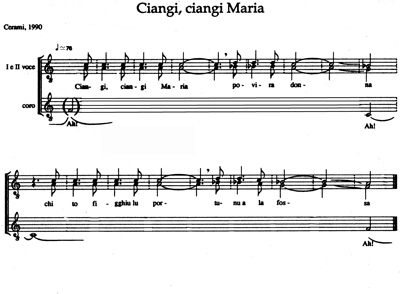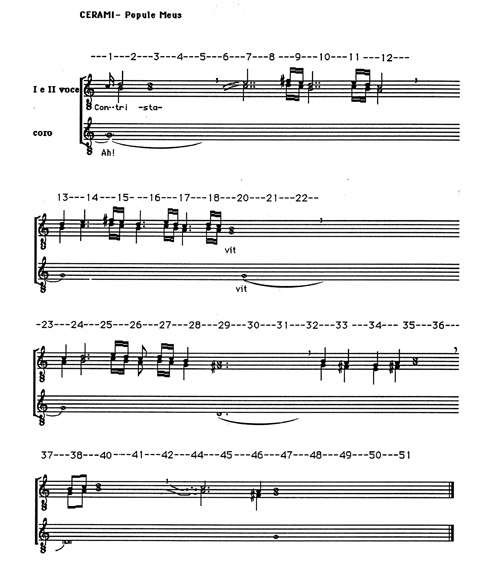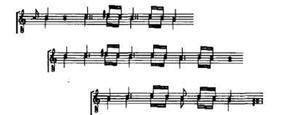|
The Holy Week repertoire of Cerami comes to the listener’s attention owing to its particular characteristics: the constant presence of two solo voices advancing by parallel thirds and the concomitant existence of antithetical musical and linguistic codes. Indeed, unlike those of other Sicilian boroughs, pieces coexist in the Cerami repertoire characterised by a melodic line rich in melismatic embellishments and an extremely free rhythmical beat, alongside others that present a melodic line that is nearly syllabic, and a rhythmic beat that is articulated into regular pulsations.
Whilst in the former the melodic performance is akin to that of many forms of monodic singing in Southern Italy, in the latter the similarity with analogous repertoires of central and northern Italy is significant. Also very interesting is the relationship between them and 16th century polyphony. As regards the choral intervention, the constant presence of whole chord created by the overlapping of parts on long bass notes 5th and 1st degree of the tono d’impianto (basetone) should be stressed.
A particular technique is also put into effect by the chorus when, by extending the final chord of a verse until the start of the subsequent one, solutions of continuity are not created within the song. A compositional procedure that takes us back to that of the metre called a ottavi 'ncruccati or even 'ncruccatura (from croccu, meaning “hook”), very frequent in Sicilian poetry, for the enchainment of the rhyme to the last verse with the first verse of the following stanza.
It is a syllabic piece and presents a strong rhythmic characterisation. The two solo voices, as in the piece we will be listening to later, proceeding parallel by diatonic third intervals while the chorus intervenes with long base notes on the 5th degree and on the 1st of the tono d'impianto. The musical stanza, which coincides with the verbal one, is formed by two phrases: the first, a suspension, ends on the 5th degree with an harmonic overlap of intervals of perfect 5th and 7th minor; the second, by wholly reproducing the initial elements of the first, leads the piece back to the finale.
The second piece is Popule Meus, one of the Latin texts most recurrent in the Sicilian repertoires of the Holy Week together with the Vexilla regis, the Stabat Mater, and the Miserere (Psalm 50). As I have already said, they spin off from the official Catholic liturgy prior to the dictates of the Second Vatican Council. In particular, the Popule meus is part of the Improperia, which is a series of laments that the Lord addresses towards the Jewish people for their ingratitude towards his actions. The use of these texts harks back to that of the history of Catholicism concerning the establishment of the brotherhoods and the relations that the Church of Rome was weaving with them. It is clear that at the time the lexical understanding acquired a certain vagueness seeing that Latin was unbeknown to the vast majority of the faithful.
In the Popule meus of Cerami we can observe a strong subordination of the verbal text in relation to the musical one; in the piece the chanted word is dilated from one time to the next, split or reiterated in order to answer to a priority required by the sound rather than the meaning. The piece is made up of two formal elements that lead to a very evident suspension on the 5th degree (connoted by the change in the long base note and by the harmonic overlap of third major and perfect fifth) and a conclusion on the 1st degree of the tono d'impianto in which the chorus unites in unison with the 2nd voice.
|


